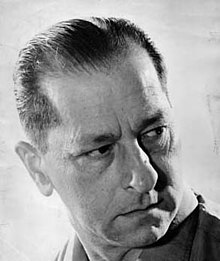Jack Oleck
| Jack Oleck | |
|---|---|
 | |
| Born | March 1, 1914[1] |
| Died | March 10, 1981 (aged 67) Massapequa, New York[2] |
| Nationality | American |
| Area(s) | Writer |
Notable works | Messalina, DC Comics horror titles |
Jack Oleck (March 14, 1914 – March 10, 1981)[2] was an American novelist and comic book writer particularly known for his work in the horror genre.
The brother-in-law of comics pioneer Joe Simon,[3][4] Oleck's comic book career was basically in two parts. During the Golden Age of comics Oleck wrote for EC Comics and the Simon-Jack Kirby Studio. After the mid-1950s temporary collapse of the industry following the publication of Fredric Wertham's Seduction of the Innocent and the establishment of the Comics Code Authority, Oleck left comics, instead writing novels and publishing an interior design magazine. From the late 1960s until his death in 1981, Oleck worked for DC Comics as a writer for their extensive line of horror/suspense titles.
Biography
Early career
Oleck's first comics credit was as a writer for Lev Gleason Publications' Silver Streak, in 1940.[4]
Oleck served in the U.S. Army during World War II, leaving the service as a sergeant.[5]
Golden Age
In 1948, using his connection as Simon's brother-in-law, Oleck joined the Simon-Kirby studio, which produced material for such publishers as Quality Comics, Hillman Periodicals, and Simon & Kirby's own Mainline Publications.[4] Oleck quickly established himself as "the number one scriptwriter for Simon and Kirby,"[3] producing romance stories, war stories and crime features, in addition to the burgeoning field of horror comics.
EC Comics editor Al Feldstein recruited Oleck in the early 1950s, where he became one of the main writers of Crime SuspenStories. Oleck also scripted stories for EC's The Vault of Horror and Weird Science-Fantasy, as well as the EC Picto-Fiction titles, Crime Illustrated, Shock Illustrated and Terror Illustrated.
Novelist and magazine publisher
After temporarily leaving comics, Oleck was the publisher and editor of Interior Decorator News from 1957-1969.[4]
During this period, Oleck wrote a popular pulp fiction historical novel, Messalina, about a female slave during the Roman era, which has been republished many times.
DC Comics
Horror comics made a comeback in the late 1960s, and Oleck joined DC Comics' stable of writers in 1969. He became a regular contributor to such titles as Forbidden Tales of Dark Mansion, House of Mystery, House of Secrets, Secrets of Sinister House, Tales of Ghost Castle, Weird Mystery Tales and Weird War Tales. He also returned to the romance field, scripting stories for DC's Young Love and Young Romance (ironically, both titles Oleck had written for in the 1950s which had subsequently been acquired by DC).[4]
For House of Mystery #194 (Sept. 1971), Oleck wrote the seven-page story "The King Is Dead", which was illustrated by Nestor Redondo in his earliest U.S. credit. Conversely, Oleck wrote the final story Golden Age artist Bernard Baily drew, the eight-page "His Brother's Keeper", for House of Mystery #279 (April 1980).
Oleck and artist Alex Niño created the science-fiction feature "Space Voyagers" in Rima, the Jungle Girl #1 (May 1974). Oleck and Alfredo Alcala created Kong the Untamed in 1975, and Oleck was the writer of the short-lived series starring Kong.
In the 1970s, Oleck wrote horror paperback novels, including two film tie-ins.
Bibliography
Novels
- Messalina (Lyle Stuart, 1959)
- Theodora (Signet, 1971), historical novel similar in spirit to Messalina
- The Villagers (Lyle Stuart, 1971)
- Tales from the Crypt (Bantam, 1972), film tie-in
- The Vault of Horror (Bantam, 1973), film tie-in
- The House of Mystery (Warren Paperback, 1973), illustrated by Bernie Wrightson
- Satan's Child (1978), illustrated by Arthur Suydam
- The Rites of Spring (1982), illustrated by Arthur Suydam
See also
References
- ^ "United States Social Security Death Index," index, FamilySearch (https://familysearch.org/pal:/MM9.1.1/JT1G-C61 : accessed 19 Mar 2013), Jack Oleck, March 1981.
- ^ a b Social Security Death Index, SS# 115-01-6988.
- ^ a b Simon, Joe and Simon, Jim. The Comic Book Makers (Vanguard Productions, 2007) ISBN 978-1-887591-33-1.
- ^ a b c d e Oleck entry, Who's Who of American Comic Books, 1928–1999.
- ^ Foxhole (Mainline Publications, 1956): billed as "written and drawn by actual veterans."
Sources
- Jack Oleck at the Comic Book DB (archived from the original)
